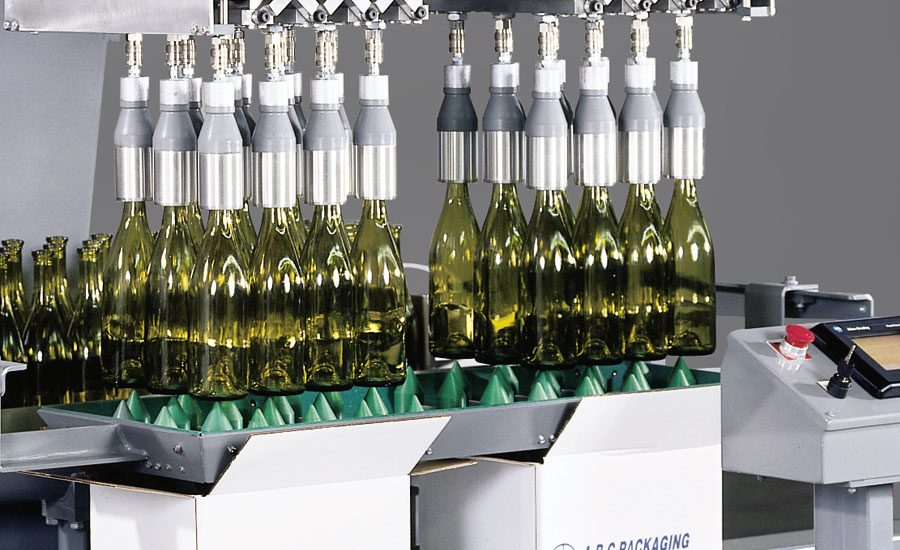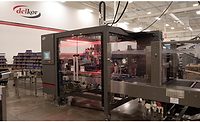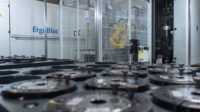With its glow-in-dark and LED race car, THE AS Seen on TV brand Magic Tracks, as its ad slogan states, has the ability to “bend it, flex it, curve it to the max” to create a custom speedway for any home. Although beverage warehouses also are in need of flexible solutions, assembling them is not as easy as snapping a few pieces together, which is why they depend on original equipment manufacturers (OEM) to develop machinery for today’s warehouses as well as the warehouses of the future.
For case packing and wrapping operations, flexibility is one of the most important attributes for which beverage manufacturers are looking, suppliers note.
“Flexibility is a top requirement from our beverage customers,” says Bryan Sinicrope, vice president of sales and marketing for A-B-C Packaging Machine Corp., Tarpon Springs, Fla. “Whether they are trying to maximize their production lines to run multiple products and/or sizes, or anticipating future needs, they need machinery that can adapt. And, beverage processors need machines that can be quickly changed from one size/configuration to another, which is driving the development of machines that can run a wide range of products with reduced changeover requirements.”
Sinicrope notes that the need for flexible packing and wrapping machines stems from the SKU proliferation within the beverage market. “I think a lot of it is driven by consumers’ interest in new beverage products, and manufacturers’ drive to fill this need,” he says. “One way to stand out on the shelf is with a different package, whether it is the primary container (can, bottle or carton) or the secondary packaging.”
Mike Brewster, director of sales and marketing for Brewerton, N.Y.-based Schneider Packaging, echoes similar sentiments.
“Organizations’ marketing departments are constantly changing the size/shapes of their consumer-ready products,” he says. “Whether a product is undergoing a quick aesthetic change or a massive overhaul, the frequency of change amongst organizations is driving our industry to manufacture equipment with an efficient changeover process to mitigate downtime.”
Don Swanson, beverage sales manager with Alexandria, Minn.-based Douglas Machine Inc., says that engineers are insisting on flexible machinery in order to accommodate the new products and packaging that marketing teams are developing. “The desire to have multiple sizes and sizes changing as the market changes is important. The ability to adapt to those changes is imperative in old and new equipment.”
Swanson adds that because flexibility tends to be a top priority for beverage manufacturers, Douglas Machine offers three-in-one packaging capability such as film only, pad film and tray film. “Flexibility in container sizes is also driving innovation like the Douglas SmartSelect automatic infeed changeover,” he notes.
SmartSelect is equipped with an automatic changeover feature for multi-lane infeed conveyors and infeed rails, the company says. Independent rail positioning provides for fixed-side, center-adjust and variable-width positioning of multiple lanes, it adds.
Recently, Douglas Machine also highlighted its TriVex RLi top loader and sealer for the wine, beer and spirits markets. The integrated solution doubled a customer’s process speed and can run seven bottle sizes, including 200 ml, 500 ml and 1.5 liter, the company says. The bladder-controlled end effector and funnel grid system provide product stability while an automated flap control system for
re-shipper RSC cases feeds the case into the loader at 37 cases a minute, it adds.
Because flexibility and quick changeovers can have such a large impact on case packaging and wrapping operations, Swanson recommends that beverage-makers ask themselves the following questions before investing in new equipment:
- Will the equipment that you are considering be flexible enough to handle different products in the future?
- Will it be able to handle potential speed increases as the case unit gets smaller?
Schneider’s Brewster also notes the importance of quick changeovers in beverage operations. “Organizations are looking to accomplish a changeover from one product to another in the quickest and most efficient way possible,” he says.
Brewster adds that it is important for beverage manufacturers to consider the ability and probability of amending products based on consumer and market needs before investing in new case packing and wrapping equipment. “They also need to be on the forefront of innovation to know, as the next generation comes into the consumer fold, what products they will be most apt to buy,” he says.
Conscious improvements
Although flexibility and quick changeovers garner a lot of the attention when selecting case packing and wrapping equipment, beverage-makers also are conscious about the environmental impact of this machinery.
“Every organization becomes more conscious of their impact on the environment each and every year,” Brewster says. “One way we have helped organizations reach their sustainability goals is to build more energy-efficient equipment. We can minimize their downtime by having certain components turn idle after a certain period of time, which saves energy immediately and then again on the restart.”
Todd Welker, beverage sales manager and regional sales manager with Douglas Machine, also notes the importance of energy efficiency for case packers and wrappers. However, he adds that machinery is adding lightweighting trends for packages and packing materials.
“Material lightweighting, such as removing plastic from bottles and using thinner films, have an impact on stability and control of the products and materials through the machinery,” he says. “Continual control of the products/materials is imperative as this trend continues.”
A-B-C Packaging’s Sinicrope also notes the importance of balance when lightweighting materials. “All of our customers are looking for the sweet spot of reducing their packaging while providing maximum product protection,” he says.
In addition to sustainability practices, case packer and wrapper manufacturers also must remain conscious of retail merchandising trends.
“The drive for shelf-ready cases (SRC) or retail-ready cases (RRC) means the relationship between the board supplier, the machinery supplier and the end user all need to work together to design the appropriate package,” Douglas Machine’s Welker says.
He adds that speeds have been increasing because of requirements from retail chains, including Wal-Mart Stores Inc.
Going forward, Welker and Swanson expect that smaller packages and higher speeds due to those smaller sizes will impact case packer and wrapper manufacturers as they remain conscious of beverage-makers’ flexibility needs.
Schneider’s Brewster also anticipates case packing and wrapping innovations will be driven by “making improvements to increase uptime while adding the flexibility to run an array of products.” BI





